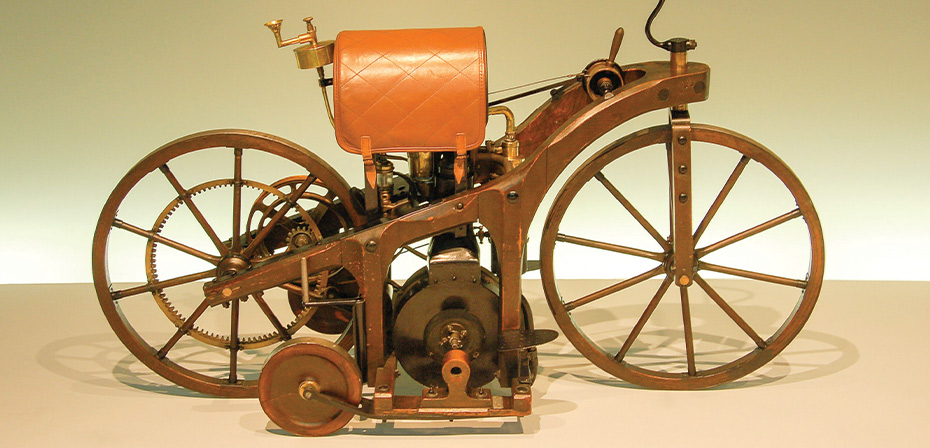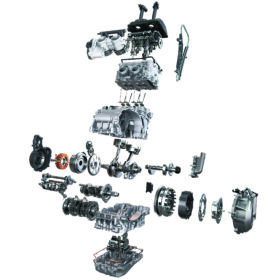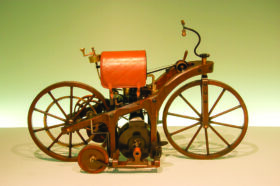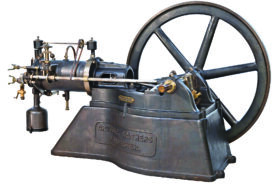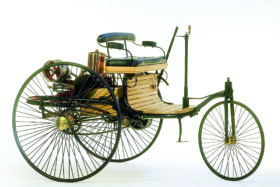Our world just wouldn’t be the same if it weren’t for the internal combustion engine.
I freely admit to my obsession with the internal combustion engine, particularly with the four-stroke variation. Fortunately, I have chosen the motorcycle as the device with which to enjoy the sounds, smells and feel of the internal combustion engine. Sadly, due to its unsavoury relationship with nature, the gasoline-powered engine is on its way out. It has, however, served mankind and dominated the transportation industry — and much, much more — for more than a century.
The internal combustion engine serves a simple purpose: It converts heat into motion. To do this, it uses the expansion of heated air — produced by igniting a fuel and air mixture — to push on a piston inside a sealed, cylindrical chamber. The reciprocating motion of the piston is converted to rotating motion by connecting it via a rod to a crankshaft, a device invented by a mechanically minded genius named Leonardo da Vinci. That rotating motion can then be used to drive a number of things, from wheels to propellers to electric generators, and on and on.
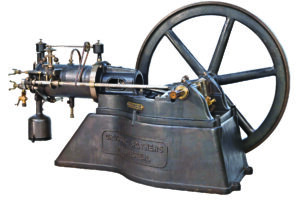 If it were not for the efforts of a few brilliant engineers who dedicated their time to help develop this simple device, we would probably still be riding in horse-drawn carriages. Okay, maybe something else would have eventually been invented that would facilitate travel, but it cannot be ignored that the invention of the internal combustion engine changed the course of mankind.
If it were not for the efforts of a few brilliant engineers who dedicated their time to help develop this simple device, we would probably still be riding in horse-drawn carriages. Okay, maybe something else would have eventually been invented that would facilitate travel, but it cannot be ignored that the invention of the internal combustion engine changed the course of mankind.
French engineer Alphonse Beau de Rochas patented the concept of the four-stroke cycle engine in 1862, but he never built one. A few years before this, Belgian inventor Jean Étienne Lenoir had developed the two-stroke engine, and actually had a working model by 1862. In 1861, German engineer Nikolaus August Otto was also working on a two-stroke engine based on Lenoir’s design, but his first attempt at a running model failed almost immediately. This prompted him to look at alternatives, and he turned his focus on Rochas’ four-stroke cycle design. While the four-stroke engine contained more parts than the two stroke, and it lost one revolution in order to complete the four strokes — intake, compression, combustion, exhaust — it ultimately proved more reliable and more efficient thermally. It has therefore dominated engine production ever since, in a multitude of layouts, and for countless applications.
The four-stroke cycle engine — or the Otto Cycle engine as it is also known — revolutionized transportation. While automobiles were early recipients of the internal-combustion engine, motorcycles were there first. This engine was compact enough that in 1885 it prompted Gottlieb Daimler to put one in a bicycle-like vehicle that had a pair of tandem wheels and a pair of smaller outrigger wheels, thus producing what is widely considered the grandfather of gasoline-powered motorcycles.
A year later, Carl Benz made his first public appearance in his patented “vehicle powered by a gas engine.” It was a single-cylinder, four-stroke three-wheeler, which by today’s standards would still be considered a motorcycle.
While motorcycles were relatively affordable in the early 20th century, making them the primary gas-powered vehicles as opposed to automobiles (which were reserved for more affluent road users), Henry Ford changed that with his invention, the assembly line, which produced the cheap, abundant Model T. From that point on, the motorcycle became more of a novelty than a primary source of transportation.
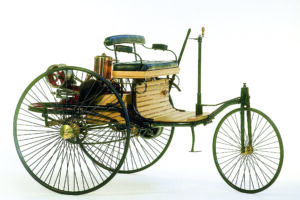 Visionaries Orville and Wilbur Wright also saw the potential of Otto’s engine, and they put a propeller on the end of the crankshaft of a four-cylinder engine, and launched the first powered flying machine into the air in 1903 — coincidentally, the same year Harley-Davidson was founded.
Visionaries Orville and Wilbur Wright also saw the potential of Otto’s engine, and they put a propeller on the end of the crankshaft of a four-cylinder engine, and launched the first powered flying machine into the air in 1903 — coincidentally, the same year Harley-Davidson was founded.
While that first flight left the ground for only 120 feet and lasted 12 seconds, their wood-and-linen aero-plane would push others into the sky, and eventually lead to putting a man on the moon. Although spacecraft is not powered by an internal-combustion piston engine, space flight would not be possible today if the Wrights hadn’t experimented in that field in Kitty Hawk, North Carolina. And that wouldn’t have happened if it weren’t for the gears turning in Otto’s head.
Why am I obsessed with the internal combustion engine? Well, I couldn’t ride a motorcycle without it. At least not one that feels like a living, breathing thing; vibrating, producing heat, and taking me wherever I want to go. When sitting on a motorcycle, you are intimately close to the engine; your legs straddle it; your arms extend forward above it. It is not hidden beneath a hood; it is out in the open, on display as a central design piece. It is an intricate part of the riding experience; its sound, power pulses and vibration often tuned by its designers to give it character.
I do understand and respect the move to protect the environment and the air we breathe, but I’m also glad we’re not done with pistons just yet.









